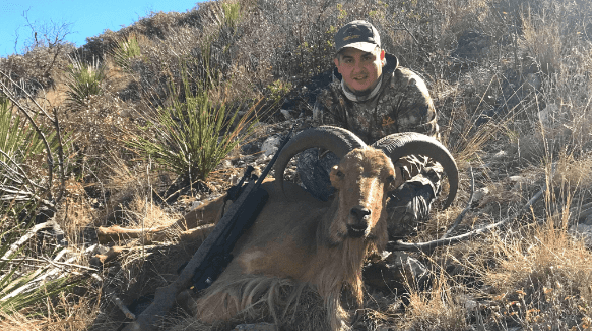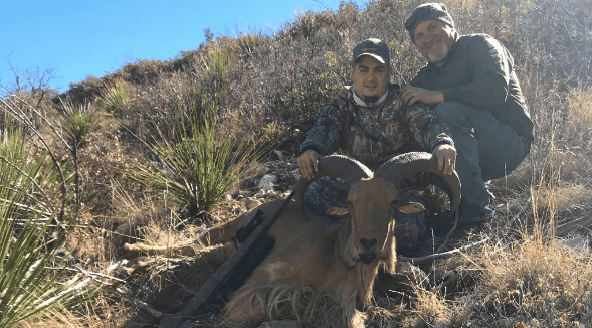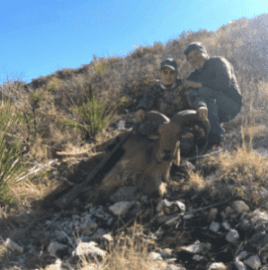Rough Country Aoudad
By John A. Urby
Chasing West Texas aoudad is the most challenging free-range hunting I have experienced in my years visiting the Glass Mountains, south of Fort Stockton. Hunters have the opportunity of glassing rough mountains and endless horizons in search of the elusive aoudad. This yearly adventure included my youngest brother, David, and his son, D.J., who would be this year’s shooter. We were blessed to hunt on the Dacus and Sibley ranches.
After arriving mid-afternoon and unpacking supplies in the well-equipped hunters’ quarters, we set out to scout the thousands of acres we would be hunting. I was driving my Lannom Hunting Buggy. I was fortunate to purchase my buggy in 2004. We took a backup UTV while hunting remote areas of the ranch.
Hunting vast mountain and open ranges require extensive glassing and driving off road, often over rocks, ledges, gullies, cactus, and shrubs. I cannot stress the importance of using quality binoculars. Once animals are spotted, a stalking plan gets developed. The stalk usually involves climbing or trekking across uneven terrain and mountainsides. As ranch owner Jim Dacus describes, “This county will bite you.” As I would soon learn, the rocks do, in fact, “bite!”
Our first afternoon, we spotted three young aoudad rams on the side of a distant mountain. We decided to continue looking for mature aoudads. We saw mule deer, javelinas and elk, so wildlife was abundant. We settled in for an evening of fellowship, joined by Mr. Dacus, while enjoying my brother’s grilled chicken recipe.
Early the following morning, we left camp after enjoying a breakfast of chorizo and bean burritos. We continued to drive on and off ranch roads, stopping often to glass the mountains that sometimes surrounded us. On a mountainside some 500 yards away, we spotted three mule deer grazing on the side of the mountain. The mule deer were oblivious to us watching them because they seemed to draw their attention to something behind them. I looked through my binoculars and spotted a lone coyote, following leisurely towards the mule deer. The coyote seemed to notice us watching and slowly trotted toward the mountain summit. In a few minutes, the coyote was gone, and the mule deer continued grazing.
As we continued our quest, we saw more wildlife, including scaled quail and rabbits. One group of six elk included one large elk we identified as a bull that had shed its antlers. The country we were hunting in was beautiful, magnificent and breathtaking. We wondered how there could be so much open uninhabited country.
Fox Canyon is a beautiful canyon that stretches for a couple of miles on both sides of a rugged ranch road. We worked the canyon, stopping to glass to the right and left, and in the direction ahead. As I drove out of a rock-wash gulley, D.J., sitting in the top shooter’s seat, shouted, “Stop!” He saw a single aoudad ram standing near an intersecting gulley some 175 yards from the buggy.
I quickly turned off the ignition as we continued to glass and evaluate the quality of the aoudad. Knowing aoudad often travel in groups, I looked for other aoudad that might be in the area. If the aoudad was indeed by himself, my experience showed me the older aoudad sometimes gets kicked out of the group by younger, more powerful rams. I hoped the aoudad was alone.
As I stood next to the buggy, I noticed only the horns of a second aoudad ram standing closer to the gulley. His body could not be seen. I had D.J. and David walk to a higher location so they could evaluate the second aoudad. D.J. was shooting with a .308 WSM and a quality tripod.
After a few minutes, D.J. fired his rifle in the direction of the second aoudad, which was eating grass on the side of the mountain near the gulley. At the report of the rifle, I watched the aoudad fall to the ground. The first aoudad began running across the mountainside until he went out of sight. Congratulations and high-fives were in order. We were very happy D.J. had taken a nice aoudad ram.
We drove the buggy to a safe location approximately 50 yards from where the animal fell. After some quick photographs, we began to move the aoudad from the mountainside to where we parked the buggy. After field dressing the aoudad, we took turns grabbing the horns and pulling the animal. With a dressed weight still over 150 pounds, the aoudad was a challenging pull.
After taking a break, I decided to walk down the mountainside towards the buggy. As I walked sideways on the rocks, I lost my footing and fell to the ground, twisting my right ankle in a direction it was not intended to bend. The pain was immediate as I lay on the ground. David and D.J. came to my aid and helped me to the buggy.
I wore tall hunting lace-up boots that possibly prevented further injury. After loading the aoudad we drove to hunting camp. I continued to experience pain and swelling around the right ankle for the remainder of the trip. Still able to drive the buggy, we stayed at the ranch for an additional two days. Although I had a limp, I continued enjoying the hunting trip.
Upon returning home in Conroe, I was referred to a foot specialist who examined my ankle. He found I had suffered a closed fracture of my right fibula. This was the first time in over 20 trips to the Glass Mountains I had ever been injured. I am extremely thankful to my brother and nephew for their immediate attention and to my wife who has served as my caregiver during my recovery. Although I suffered the “bite” of the Glass Mountains, I look forward to visiting and hunting in this rugged country again.







